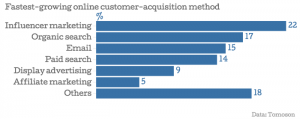It is said that the phrase “a picture is worth a thousand words” was first used by a newspaper editor who was discussing publicity back in 1911. Some 103 years later, the same is true – even more so! And savvy marketers are updating the lexicon, taking that old-timey turn of phrase even further by stating, “If a picture is worth a thousand words, a video may be worth a million.”
Statistics show us that the use of video for business communication is exploding. According to MarketingProfs, each person in the U.S. consumes an average of 19 hours of online video content each month. This trend is likely to increase – Cisco expects the number of people watching online videos to double to 1.5 billion by 2016. As we all know, videos are a great way to get a lot of information across succinctly, and research shows that video can hold attention longer than audio or text alone. In fact, according to ON24’s customer benchmarks data, live video events are watched for a 20% longer average duration than audio-only events.
So, no matter what business you’re in, it’s likely that your customers are increasingly tuning in to video content online. But what are small and medium-sized businesses to do? They simply don’t have the resources for fancy productions or expensive video gear that big companies have. However, as a crucial marketing component, companies of ALL sizes need to harness video and make it part of their mix – even though they may not have the latest and best tools at their disposal.
Clearly, the primary barrier to video adoption is technology. But all organizations, including SMBs and even small groups within big companies, can be creative and overcome tech-related obstacles.
First of all, SMBs may lack the necessary technical equipment, including high-quality cameras, speakers and good lighting, needed to produce a professional video. But the workaround for this is simple – the advent of newer, cheaper video technologies that can deliver high-quality images and audio. In addition to platforms and solutions that may immediately come to mind like GoPro, YouTube, Vimeo and Vine, there are also other formats, like video webinars, that enable you to reach thousands of people in an interactive and professional way, without the need for IT expertise. With webinars, you can also track and rank leads to better measure your results.
With the latest tools from ON24, producers can now easily incorporate high-quality video into live webcasts. We’ve updated our webcam offering with better encoding standards (H.264). With H.264 codec encoding directly from a webcam, your audiences will see a much clearer video image when viewing webcam webinars. The market is responding enthusiastically – the number of webcam events on our platform has increased six-fold this year.
Another recent product enhancement enables broadcast video, bringing powerful video capabilities to webinars. Producers can now easily incorporate broadcast-quality HD video into live webcasts, complete with auto-archive for on-demand viewing. And that’s exactly what they’re doing – the number of broadcast video events has tripled.
In addition, a new capability featured in our latest product release enables producers to leverage the power of video in a Webcast Elite Portal – making webinars even more memorable by giving them the YouTube treatment. The new Webcast Elite Video Portal presents your webinar library with a chic, current, video-centric look and feel. Producers simply post the new “Single File Archive” video file that is automatically generated after each live webcast. Viewers can access presentations more easily, enticing them to explore and engage with your impressively visual online channel.
So, with a bit of creativity and focus (pun intended!), integrating high-quality video content into marketing programs doesn’t have to be impossibly daunting. And once the video content is created, you can maximize the investment in video content by chopping it into “digestible” segments and redistributing portions of it across social media, the company website and partner/customer newsletters, for example. The specific content of the video will determine the channels that are most appropriate, and your audiences will surely enjoy being able to experience your content via video.
Audience demand for video is growing rapidly, and the business that can overcome technology challenges stands to gain. Those that don’t will be left behind. Text- and audio-only communications may well become as “quaint” as the fax and Rolodex.
Digital & Social Articles on Business 2 Community
(346)
Report Post


